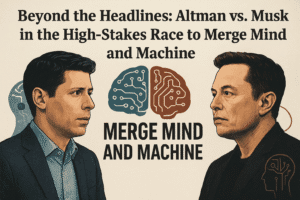Beyond the Headlines: Altman vs. Musk in the High-Stakes Race to Merge Mind and Machine
Sam Altman’s backing of nascent startup Merge Labs sets up a direct challenge to Elon Musk’s Neuralink in the critical brain-computer interface (BCI) arena. While Neuralink pioneers invasive surgical implants focused primarily on restoring function for paralysis patients, Merge Labs champions a fundamentally different path: pursuing less invasive technology avoiding major brain surgery, heavily leveraging AI for signal interpretation. This divergence highlights a key industry tension – balancing power against accessibility.
Beyond medical restoration, Altman’s involvement signals Merge’s ambition toward enhancing human capabilities and seamless human-AI integration. The rivalry accelerates progress as real-world demonstrations, like brain-controlled robots and speech-restoration breakthroughs, prove BCI’s transformative potential. Ultimately, this competition isn’t just about technology; it’s about defining how safely and equitably humanity merges cognition with machines, raising profound ethical questions alongside its immense promise. The race to connect our minds is now undeniably underway.

Beyond the Headlines: Altman vs. Musk in the High-Stakes Race to Merge Mind and Machine
The brain-computer interface (BCI) arena just got significantly hotter. News that OpenAI CEO Sam Altman is backing a new venture, Merge Labs, positions it as a direct challenger to Elon Musk’s established Neuralink. But this isn’t just a billionaire tech rivalry – it signals a pivotal moment where competing visions for connecting our brains to machines are moving rapidly towards reality, promising profound changes to human health, capability, and our very relationship with technology.
Neuralink: The Surgical Pioneer
Neuralink, founded in 2016, has undeniably pushed boundaries. Their focus has been on invasive brain implants, requiring neurosurgery, primarily aimed at restoring function for individuals with severe paralysis. Their recent human trials mark a significant milestone, validating the core technology and propelling the company towards a $9 billion valuation. The path is surgical, complex, but undeniably powerful for targeted medical applications.
Merge Labs: The AI-Powered, Less Invasive Challenger
Enter Merge Labs, reportedly in its early stages but with ambitious goals fueled by Altman’s backing and a targeted $250 million funding round. While sharing the ultimate vision of seamless human-AI integration, Merge Labs appears to be charting a distinct course:
- Prioritizing Less Invasive Approaches: Their most critical differentiator. Merge is explicitly exploring technologies that avoid the need for major brain surgery. This could involve advanced wearable sensors, minimally invasive techniques, or novel interfaces positioned outside the skull. This approach potentially lowers the barrier to entry, reduces risks, and broadens the potential user base beyond critical medical needs.
- AI at the Core: Merge plans to make “heavy use of artificial intelligence” to interpret complex brain signals and enhance the interface’s functionality. This suggests a focus on sophisticated software and machine learning to compensate for potentially less direct neural access than invasive implants, aiming for smoother and more intuitive interaction.
- Beyond Restoration, Towards Enhancement: While medical applications are undoubtedly part of the picture, Altman’s involvement hints at a broader ambition hinted at in the report: enhancing human capabilities and creating a fundamentally smoother connection between human cognition and AI systems. Think beyond controlling a cursor – imagine seamless thought-to-text, instantaneous language translation in your mind, or controlling complex environments intuitively.
Why This Rivalry Matters Now
The timing is no coincidence. The broader BCI field is experiencing explosive momentum:
- Real-World Demonstrations: Events like the 2025 World Robot Championship showcased brain-controlled drones and robots operating in real-time, proving the technology’s growing practicality.
- Life-Changing Breakthroughs: UC Davis’s system translating brain signals into speech for an ALS patient exemplifies the profound human impact possible today, restoring fundamental communication.
- Converging Applications: The potential extends far beyond medicine – imagine controlling smart homes with a thought, revolutionizing rehabilitation, creating new assistive tools, or enabling entirely new forms of human-computer collaboration.
The Road Ahead: Challenges and Implications
The Altman-backed challenge to Neuralink accelerates the entire field, but significant hurdles remain:
- The “Invasiveness” Trade-off: Can less invasive methods achieve the high-fidelity signal decoding needed for complex tasks, matching the potential of implants? This is Merge Labs’ core technical challenge.
- Safety and Regulation: Both approaches face rigorous scrutiny from bodies like the FDA. Safety, long-term effects, and data security are paramount concerns for any device interfacing directly with the brain.
- The Enhancement Question: As BCIs move beyond restoring lost function to potentially augmenting healthy individuals, profound ethical and societal questions arise about accessibility, equity, cognitive liberty, and what it means to be human.
- Market Viability: Securing funding (like Merge’s $250M target) is crucial, but translating complex lab tech into safe, reliable, and affordable consumer or medical products is a massive undertaking.
The Human Insight: More Than Just a Tech Race
This isn’t merely a story of competing companies; it’s a race to define the nature of our future interaction with intelligence itself. Neuralink offers a powerful, direct, but surgically intensive path primarily focused on healing. Merge Labs, backed by one of AI’s foremost leaders, champions a potentially more accessible route supercharged by AI, aiming for seamless integration and enhancement.
The winner won’t just be the company with the highest valuation, but the approach that best balances safety, efficacy, accessibility, and societal acceptance. The breakthroughs happening now – restoring speech, controlling devices, piloting robots – are just the opening chapters. The competition between these visions, fueled by figures like Altman and Musk, ensures that the future of merging mind and machine is arriving faster than many anticipated, promising both incredible opportunities and demanding careful consideration of the profound implications for humanity. The era of the connected brain is dawning, and the stakes couldn’t be higher.
You must be logged in to post a comment.